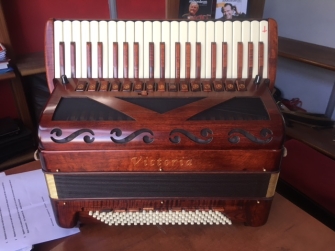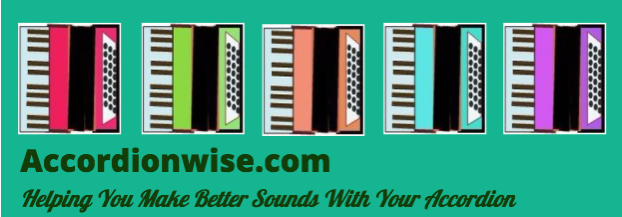I HOPE YOU ENJOY THIS WEBSITE
My name is Alex Govier, a professional musician on accordion, piano and organ for over 50 years.
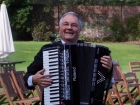
On this website I am sharing stuff to
- Improve your technique
- Help you get to know your instrument better
- Play more easily and more confidently
- Try new accordion bass methods
- Integrate bass and treble sounds in different ways
- Learn how to make better music
- Gain popularity with general music listeners and not just fellow accordionists.
And yes, ALL CONTENT ON THIS WEBSITE IS FREE.
Simply because I would like more general appreciation of this wonderful instrument.
Because by playing a little more thoughtfully we can reach new audiences and get more recognition.
Find when there is new stuff on this website by joining our new Facebook Community
Here you can also
- interact with this website on Facebook
- Ask questions
- Request more detail on an accordion subject
- Suggest a new subject
- Tell us your own ideas and more.
The Accordionwise Friends link
You can find my personal playing sites on
Easy Ways to Improve Your Sound
The accordion's instant response to the bellows and instantly produced bass and chord accompaniment patterns make it potentially a very expressive instrument.
Unfortunately because of its ease of use in the initial stages, novice players remain satisfied with being able to play a recognisable tune instead of making it really nice to listen to.
The Best Way to Get a Better Sounding Accordion
Basically the best way until you find the money to buy that wonderful new Italian accordion you always wanted is to use the one you have got better.
This means playing with more thought to your style and arrangement instead of just dashing off the tunes so they are recognisable rather than inspiring.
I think if you play from the heart rather than just relying on the usual automatic responses in your fingers and arms you will be amazed how your accordion sounds will improve.
![]()
The Heart of the Accordion, the Bellows
In every sense the heart of the Accordion is the Bellows, it breathes when you use it and by playing in harmony with it you can put heart and expression into your music. Feel the connection with your bellows as your notes are expressed through it.
So the heart of the music is also in the bellows.
It is a wonderful feeling to be in unity with your instrument and making your melodies sing out and I believe you should not play any melody unless you feel it inside.
As you operate the bellows you are directly connecting with the reeds of the instrument, so are directly able to continuously control the sound in a truly exciting manner.
This is a lot more than making enough noise! You can enable or cut off the notes fade away or crescendo the tone through a phrase, and even when you have chosen the starting power of the note you are still able to make it grow or fade if this fits the music.
Just feeling that connection while you play will improve your approach and make your sound better just by itself.
A friend of mine told me he decided not to play the accordion because he tried it and the bellows was too stiff. But of course this shows a fine airtight bellows and it should not move unless you are playing notes.
So he rather missed the point!
![]()
Basic Bellows Technique
At its most basic bellows technique is about not running out of air in the middle of a music phrase, as the "gasp for air" sounds offputting, amateurish and unmusical.
Emphasis is always placed on changing bellows direction after, at most, two short musical phrases to avoid this and is part of classical accordion teaching.
The necessity for this changes with the way you are playing, how many notes simultaneously, if you are playing legato and how many reeds are selected by the registers in the right and left hands. Often if you are playing heavily and loudly, you may only manage a couple of bars at a time.
Obviously, this is a sensible starter method.
Some people have i believe developed a bellows control which enables virtually no loss of air to be heard between opening and closing the bellows, but I think it may still be detectable and would not myself want to risk that I was not as good at it as I thought I was!
The Rebel Method
So what about long phrases played smoothly and loudly on bellows that do not expand to 20 feet apart?!!! And I do like to hear those extended musical phrases and to play them.
There will be natural places to change, for example between one set of four quavers (eighth notes) and the next, or the next note of any length.
Being, as you probably know by now, a naturally contrary kind of person, I will suggest the opposite technique.
If not in too fast a tempo put the bellows direction change somewhere in the middle of a set of the faster notes, probably best after the 1st or 3rd quaver, to insert a subtle phrasing break and probably no-one will supect a thing!
Such as Diddledid leDiddlediddle - See what I mean?
It is important to separate the actual playing of the notes and of course synchronise them to that moment when the bellows is changing direction. Then you will definitely not hear that gasp, just a nice very subtle deliberate phrasing effect!
![]()
If Your Bellows is a Source of Fatigue
Sometimes of course if you have to play for a long time it can become a bit physically demanding to have to keep moving the bellows, particularly pushing it back in.
When you are expanding the bellows the weight of the bass section is often going a little more towards the ground and the action is therefore helped by gravity. When pushing in though, gravity is against you and you are also working to compress the air pressure that is in there.
Additionally you may be playing where it is uncomfortably hot or cold.
You need to make the physical effort minimal to overcome this successfully.
Try lifting the left hand side of the accordion while squeezing in so that gravity now helps push the bellows together towards the right hand side. Furthermore if they play sitting down they have their right knee higher supporting it on the outward journey and then raise their left knee instead.
Then your means of expression becomes a matter of just assisting or discouraging the force of gravity, according to need.
![]()
Musical Expression from the Right hand Tune
When speaking you would not make all words equal to express the meaning, or whisper when giving a command or shout when saying words of love so obviously the same applies to music.
Plus the meaning of a sentence changes completely when stress is applies to different words. Take a simple sentence and apply stress to different words and the inference of why it is being said totally changes!
She didn't want to go to the party - She didn't want to go to the party - She didn't want to go to the party - She didn't want to go to the party - She didn't want to go to the party
And music works just the same. So play your song as you would say it or hear it sung by an expert singer. Bear in mind also that a singer would not apply just mathematical division in the bar but sing freely. Your basic rhythm should be safe in the care of the bass buttons.
PLAYING TIP Repeat any musical phrase and try applying strength to a different note (or notes) each time and hear how it almost changes into a different tune.
![]()
Vary the Phrasing
The same principle of different meanings depending on emphasis applies to how different tunes can be, just by phrasing different numbers of notes together by creating gaps between the notes at different points.
The only way to do this and maintain the tempo is to play the last note of a phrase light and stacatto. Once you have held on like grim death to that note you have run out of options for creating a separate phrase after it!
| Try a tune out and insert breaks on different notes and notice how the meaning of the tune changes |

The accordion shares a necessity to phrase by its very nature (by virtue of its restricted bellows air capacity) with other instruments. With the violin the length of the bow dictates a change of direction when necessary, and wind instruments are restricted for the length of a phrase by the player's lung capacity.
However putting extra breaks in like this can enliven and remould the tune and breaks should be put into the melody to lighten and highlight it, not just because of dire necessity
![]()
Two note phrases
Some music has phrases of only two notes such as the Dance of the Hours main theme parodied in the 70s as Hello, Mother, Hello, Father, Here I, am at, Camp Gran, ada.
You can see how necessary it is to cut the second note off of each pair of notes to allow for the next pair to come in cleanly. Also in this case
Your first ever music teacher will have shown you how to play smoothly and join all your notes up legato, but this is deadly to musicality (and hence listening enjoyment) if used all the time afterwards, and it very often is!
![]()
Emphasise The Stronger notes in the bar
As a general rule Beat one is emphasised in both four beats to the bar and waltz time and beat 3 almost as strongly in four time.
If you want to save the extra bellows attack for particular notes in the melody as in the earlier paragraphs you can get the same effect of emphasis by joining beats 1 and 2 in three or four beat time. Also of course joining 3 and 4 in four beats.
Long notes sound louder than short ones to the ear and I believe this effect is more musical than stomping equally or even playing equally staccato on each bass button (which is the traditional accordion teaching)
Try it, you may like the effect. I am pretty sure your audience will.
EXTRA TIP If you find your extra bellows attack for doing this is too exaggerated in volume, get the same effect by reducing the bellows where the stress is not needed.
![]()
Reverse Expression can be very effective
Although the normal rule is that a melody tends to want to rise in pitch and volume at the same time it can be very effective to reverse this rule, particularly where a
jump upwards four notes or more is involved.
If you cut back on the volume of the new high note in this instance this can be very emotional in effect. The sudden difference of pitch will tend to accent the new high note anyway so the effect of restraint can be very pognant and emotionally effective.
![]()
Playing Slow and smooth Tunes
Not much done unfortunately on accordion but I think it should be. It brings out the depth of tone of your accordion.
Just play normal basic pattern (Note then Chord alternately) but join and even overlay them. Just doing that make it sound entirely different than "seesaw" button pushing.
Easy!! But also this
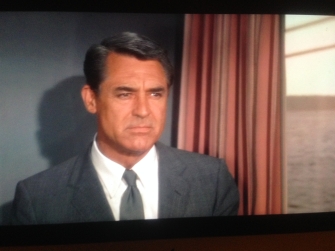
 More Even Smoother Sounds
More Even Smoother Sounds
Also playing slow and smooth can be accomplished by adding some of the chords in the right hand, but always listening carefully to the harmony as it builds up.
Remember you are still joining these up rather than jabbing at the notes
Usually these right hand chords will start after the start of a long melody note, rather than simultaneously. They could start at the same time but this would be for emphasis, the opposite of smoothness.
Right hand chords added under long notes in the melody give you all these possibilities. Remember in the diagrams N=Bass Note K=Bass Chord and K=Right Hand Chord added below a melody note. I use the abbreviation K instead of C to avoid you thinking just of the C chord!
So, only allowing for one match per beat you have
NKNK (your basic four beat pattern, but played sustained and smooth)
NKKK (sounding like a chorded arpeggio between the right and left hand)
NKKN (more casual or with an implied movement towards the next chord)
NKKK (very smooth)
NKKN
NKNN and NKNN
Also of course usable in slow waltzes basically as
NKK
NKK
NKK
NKN
NKN
This is only the beginning of the possibilities. Realise that
a/ You can also have patterns which play more than one accompanient button to a beat with faster shorter notes (eight notes or quavers) and
b/ That the chords following one another will not necessarily be the same!
And you have seemingly endless possibilities that might make you wonder why NKNK or NKK once seemed like the only way to play the accordion!
Oh and here is another easy to remember idea, which is dealt with on another page also. You can smooth out a slow tune with a bass chord (possibly starting on the second beat of the bar) and complete the movement with quaver arpeggios under the tune in the right hand.
The bass chord can be either held or released as soon as the right hand does the arpeggio. You could also go from bass to chord in quavers in which case the right hand arpeggios will have a space to cut in earlier.
This system can also fill in nicely with gentle rock ballad style, optionally adding occasional dotted bass notes.
![]()
How Much Detail Should You Play?
Less can be More!
Matching one note in the right hand to a note or chord in the left hand every time can be monotonous and tiring on the ear for someone who is used to listening to other kinds of music.
There is a lot to be said (mainly by me probably!) for long note values in the right hand against quick short ones in the left, and vice versa.
How to make your playing sound more fluid rather than always playing note for note with the bass section
If the match note for note seems inevitable the smoothest way to get rid of it is to "move" the melody on a half beat, so that the crotchet is now dotted and the next note comes late as a quaver.
Or you could put a dotted beat in the bass instead.
It may also be good to subsitute two (or three) quick notes on one of the beats, either two bass notes, two bass chords, or even one of each.
This fiddling with the exact placing of the melody is done by vocalists all the time and I do not remember Frank Sinatra being criticised for it, quite the reverse!
Opening up the music for the next phrase
I believe if there is a fast run occupying LESS than the full bar leading into a first beat of the next bar it should be given room to breathe without any left hand until the strong beat comes in after. This could be anything up to 7 quavers (US eighth notes) in 4 time or up to 5 in waltz time.
If in the middle of a section though, you will probably need the first beat of the bar (or the main beat immnediately before the run) played briefly on bass for the run to "bounce off". It gives a secure feeling to the music.
Playing a seven note unaccompanied run like this almost makes you sound like an instant jazz accordionist!
Pruning your bass pattern. Is your bass rhythm pattern really necessary?
Be ready to cut off any slavish standard patterning in the bass at the first sign that it may be obscuring or unnecessarily duplicating an important fussy bit in the right hand.
Sometimes your ideal bass part may even be just the bass note at the beginning of the bar and the last half beat bass note or chord to pull you into the next bar.
Look at other pages on this site for examples of this, including notation examples
![]()
Correcting The Balance between The Hands
The system of playing stacatto in the left hand to make it sound lighter and quieter is too well known to need any recommendations from me.
In fact I am not all that fond of it. It can sound like mini firecrackers going off rather than musical notes! It sounds more musical if the right hand is playing more than one note simultaneously in my very personal view.
And while your right hand registers are easily changed it is another thing altogether to successfully go to a more suitable bass register mid performance if you need to emphasise it more later, if you are lucky enough to have some to choose from on your accordion of course.
But Can you still hear the chord?
I do feel that a very short chord may be too short to be identified by the ear unless the right hand is holding the chord inthe arrangement (or a couple of notes of it) for longer. Also the outboard motor like mini explosive sounds, though widely accepted in the accordion world, do not mesh with me as a listener. But maybe that is just me!
When standard repetitive bass needs toning down you can do this without sounding nervous with a strong beat on the first bar and lessening the bellows movement immediately after. Particularly useful when holding a long note or chord in the tune over it. The note in the tune will still sound strong though more percussive.
![]()
A New lighter Accordion Sound
This technique of pulling back the bellows after a note also gives you a new lighter sound which almost sounds percussive glockenspiel style particularly on bright registers and is interesting to try on slow numbers to stop them sounding too turgid.
You can really exploit this percussive effective on gradually built up mini arpeggios (small enough to hold all the notes together in the hand).
You will be operating the bellows with virtually every note to do this.
Or simply use it through a whole section as a nice sound.
![]()
Playing bass chords only
This is a nice sound of chords without the bass notes, but it can sound hesitant and selecting the right chords by themselves without the security of playing bass notes too as a guide is not easy.
PLAYING TIP
An alternative to the awkward chords on their own can sound similar and be easier to implement and more adaptable
Chords on their own are more difficult to find without some reference to the bass note row but do of course but the sound of a sustained chord is usually quite pleasant.
Sometimes it may seem a bit over vague and floaty without the support of the bass but there is a solution. If you initially play the bass note WITH the chord, the faster you relinquish the note while holding the longer chord the lighter the overall effect will be despite having provided a nice bass for the chord. You may even be able to put a simple alternate bass note in while still holding the chord.
While playing bass chords by themselves you may find some nice notes which you hear shifting as if playing in four part harmony.
This is very interesting and effective but is not the same in all keys and will be dealt with again on another page here.
![]()
Or emphasise the left hand
The most obvious way to emphasise the left hand is to stop playing the right momentarily or by altering to a heavier bass registration if you have one
Or to stop playing the bass so that it will be noticed more when it starts again!
But for a novelty you might like to try this bass tip.
This still works even if you only have one bass register.
For instant rhythmic or dramatic effect pointing up a single bass note lead sharply into it from the semitone below on the counterbass row. It should still sound like you are playing one note (with two pitches!)
You will probably need to adjust your bass fingering to allow this. Try it on 1st or 4th beat of a tango, if using a single bass note there.
![]()
Practice to play Fast and Reliably
A practice method that Works
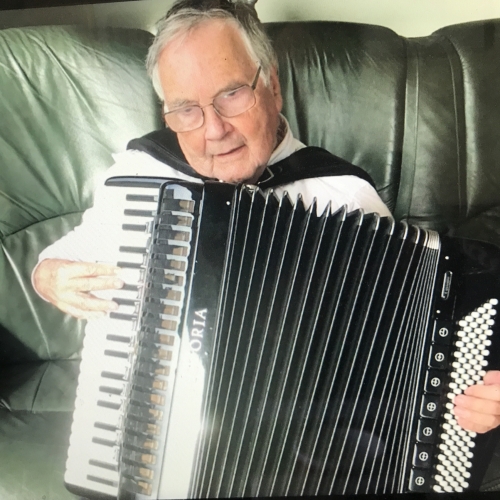 As on all instruments it is important to be able to play the whole tune fast or at a suitable tempo steadily. Not in stops and starts, which is very disturbing to listen to!
As on all instruments it is important to be able to play the whole tune fast or at a suitable tempo steadily. Not in stops and starts, which is very disturbing to listen to!
In order to do this you have to know all the sections and the movements you have to make iwth your hands equally. So you must practise them all equally.
This means when you have learned a phrase comfortably, you then go on to the next bit you are unhappy with and practise it over separately without the consolation of playing your good bit first.
Playing the earlier bit first means that it just encourages you to play it faster than the new bit as you have pracitced it more than twice as much!
You cannot take a running jump at a new bit and hope you do it, you need to deal with it as a separate entity.
![]()
But Playing Fast Particularly? Well OK!
Well you have to decide on your speed and stick to it, believe and just do it but there is probably one principle which will hold you up most. If you fall in love with a note and play it too heavily you will not be able to move onto the next note in time.
Playing fast is not a matter of tightening up your muscles to a tremendous strength of effort. That leads to paralysis not speed and ease of movement. The more relaxed your fingers are the faster you can play. Take it easy.
|
SOME NOTES ON PRACTICE TECHNIQUE: You need to be able to play the whole thing at the same speed, not just the bits that seem easy to you.
If you play the more difficult bits really slowly this is fine as long as you play the easy parts at exactly the same speed alongside them. Then every time you practice the whole tune will speed up evenly
Do not think it will work if you just play straight into a new part. It probably needs a lot of separate practice and thought without the distraction of what went before - THEN you can join it up. |
Of course you also need to play the right notes and set your speed.
You have to extablish a tempo before you start playing with a count in which continues into the piece of music at the same speed.
VERY IMPORTANT - Probably the best tip of all for ANY instrument. Always Read Ahead when playing from music. You need to be in control continuously!
You also have to know what you are playing and how you are going to do it before you start so that you can stay ahead as you go through the tune. It takes time to work out how to play something you are reading so you have to give yourself the time to do so.
Perhaps the most important of all playing techniques is to not starting playing until you are ready and have the first bar clearly in your mind and in your fingers and then continue to think your way into the next bar BEFORE playing it.
If you watch professional players you may think they are reading instantaneously but in actual fact if you could see their minds working they are concentrating on being prepared for what is to come
PROFESSIONAL TIP - How to sound in Control and play better
Very important for facile playing - Do not just hold one or two notes ready at one time. If possible have the complete phrase you are going to play in your hand and just run through the fingers in the right order.
If you do this your playing WILL sound different and in control, no matter how well you have previously relied on just taking one or two notes at a time. The ear can easily detect the difference.
If you watch professional players and wonder how they can play that fast without seeming to move this is the explanation. If your hand and fingers are in place to cover the notes you will hardly need to move at all either.

